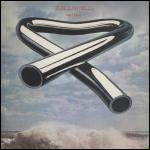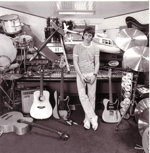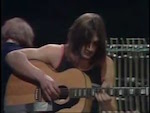Tubular Bells
Release Date: May 25, 1973
Location: The Manor

1. Part One 25:00
2. Part Two 23:50
|
Composed by Mike Oldfield except The Sailor's Hornpipe which is Trad. Arr. Mike Oldfield
Produced by Mike Oldfield, Simon Heyworth and Tom Newman
Sleeve Design and Photography: Trevor Key
Recorded at The Manor Autumn 1972/Spring 1973
PART ONE
Mike Oldfield plays:
Grand Piano, Glockenspiel, Farfisa Organ, Bass Guitar, Electric Guitar, Speed Guitar, Taped motor drive amplifier organ chord, Mandolin-like Guitar, Fuzz Guitars, Assorted Percussion, Acoustic Guitar, Flageolet, Honky Tonk, Lowrey Organ, Tubular Bells
Master of Ceremonies: Viv Stanshall
Flutes: Jon Field
String Basses: Lindsay Cooper
Nasal Chorus: Nasal Choir
Girlie Chorus: Mundy Ellis, Sally Oldfield
PART TWO
Mike Oldfield plays:
Electric Guitars, Farfisa Organ, Bass Guitar, Acoustic Guitars, Piano, Speed Elec. Guitars, Lowrey Organ, Concert Tympani, Guitars sounding like Bagpipes, Piltdown Man, Hammond Organ, Spanish Guitar, Moribund Chorus
Girlie Chorus: Mundy Ellis, Sally Oldfield
Bootleg Chorus: Manor Choir conducted by Mike Oldfield
Drums: Steve Broughton
| This stereo record cannot be played on old tin boxes no matter what thay are fitted with. If you are in possession of such equipment please hand it into the nearest police station. | |
Notes
Mike Oldfield's original demos for what was to become Tubular Bells were recorded in his flat in Tottenham, London, using a Bang & Olufsen Beocord 1/4" tape machine, which he had borrowed from Kevin Ayers, leader of 'The Whole World', the band that Mike had just left. Although only a stereo tape recorder, Mike managed to record many parts on the same tape by blocking off the erase head with cardboard and sticky tape. Instruments included his guitars, an electric organ and his mother's hoover, which Mike used in an attempt to get a bagpipe drone sound. Mike then took his demo tape to various record companies, in an attempt to gain a record deal. He didn't have much success at first, with everyone telling him that it wasn't marketable. However, he played the tape to Tom Newman while he was working at Virgin's new studio facility, The Manor, Shipton on Cherwell, Oxfordshire, England. Newman was instantly hooked, and eventually persuaded Richard Branson, Virgin boss, to let Mike have some studio time to record the album. He eventually agreed, and most of part one was recorded within the space of about a week. The rest was recorded whenever the studio wasn't being used - often late at night. Branson tried to sell Tubular Bells to other record companies. When it was clear that nobody would take it, the decision was made for Virgin to release it themselves. It was the first record released on the label, hence the catalogue number V2001 (with the 1 being the important bit).
It was usual around the time of Tubular Bells' release for rock records to be pressed on records made from recycled vinyl (partly the melted down sweepings from the floor of the record plant). The use of this recycled vinyl resulted in lower quality records - Mike (and presumably Tom Newman and Simon Heyworth as well) was not at all happy with the test pressings made on recycled vinyl, mainly because the sound of the Tubular bells themselves didn't sound right. Branson eventually persuaded the cutting plant to press Tubular Bells on the unrecycled vinyl usually reserved for classical records.
The album was recorded onto a an Ampex 2" 16 track recorder, with rumours that the number of overdubs ran into the thousands (although this has virtually been completely discounted).
Trevor Key, the sleeve designer, went on to do sleeve design and photography for acts like Jethro Tull, Phil Collins and Peter Gabriel.
His sleeve design for Tubular Bells was probably a composite - several photos stuck together. Nowadays this is done with computers...In 1973, the tools would have been a scalpel and a tin of cow gum (a certain type of rubbery glue which smelt rather bad). The back and cover photographs are both the same place - Tom Newman thinks that it was either Hastings or Eastbourne, both places on the south coast of England. The back cover shows burning bones on a shoreline (Why? Who knows...) - Tom Newman said it was either Eastbourne or Hastings, while Mike says Brighton. That front cover though...The image has become famous, especially amongst Mike Oldfield fans - the shape of that bent 'tubular bell' has almost come to represent Mike himself (which is perhaps why he chose to use it as a logo for his company, Oldfield Music Ltd).
The idea for the shape came, apparently, from when Mike hit the tubular bells for the end section of part 1. To get a heavier sound, he used large metal coal hammers instead of the wooden mallets that tubular bells are supposed to be hit with. The bells bent...this got Mike thinking. After considering ideas of tubular bells smashed or broken somehow, Mike arrived at the idea of the bell being bent. Trevor Key, an expert on photographing metallic objects, was called in, who took the idea from there…
They had previously come up with the idea of calling it 'breakfast in bed' and using one of Trevor's pictures of a boiled egg, with blood instead of yolk coming out. That picture was later used, in an altered form, for Heaven's Open. Mike thought of the title after listening to Vivian Stanshall introducing the instruments at the end of side 1 (at least, that's what he said at one time - Mike can often say different things to different people). He heard him go through all the instruments until..."Plus...TUBULAR BELLS"...at which point Mike thought "Ah, now I know what to call my album!" and the rest is history... That may not be true at all of course - the fact that Viv makes such a big thing about the tubular bells when they play seems to suggest that he knew that they were the 'title instrument' and therefore important...
Trevor constructed the 'bell' from 1 1/2" diameter metal tubing (presumably chromed) . It was probably then photographed in his studio - if it was photographed outdoors it would have had reflections of the sky in it, judging by the angle it has been taken from. If you take the cover of the LP and look closely, you can see where it has been cut out along the edges (it has been extremely well done - Trevor Key was skilled at this sort of work). The 'tubular bell' was cut out and stuck onto one of the photographs of the beach.
Personnel
| ▸ | Simon Heyworth (producer) | |
| | ▸ | Tom Newman (producer) | | Also appears in: Hergest Ridge, Platinum, Five Miles Out, Islands, Amarok, Heaven's Open, Tubular Bells II, The Songs of Distant Earth, Voyager
| | ▸ | Steve Broughton (musician) | | Played drums, guitar, bass and sang with the Edgar Broughton band.
| | ▸ | Lindsay Cooper (musician) | | British double bass, cello and tuba player, once active in the jazz scenes of London and Edinburgh. Linsay played with the Strawbs (first on cello, later on bass), alongside keyboard player Rick Wakeman. He died in 2001, aged 61. Not to be confused with the female Lindsay Cooper who played oboe on Hergest Ridge!
|
| | ▸ | Mundy Ellis (musician) | | One time girlfriend of Richard Branson and manager of The Manor.
| | ▸ | Jon Field (musician) | | Founder member of band 'Jade Warrior'. Jon played flutes in Tom Newman's psychedelic band 'July' and so was brought in by Tom to play flutes on Tubular Bells. He also plays guitar, keyboards and violin, amongst other things.
| | ▸ | Sally Oldfield (musician) | | Mike's older sister, who formed a duo named Sallyangie with him when he was 15. She went on to have a successful career as a solo artist. Also appears in: Incantations, Tres Lunas, Tubular Bells 2003
| | ▸ | Trevor Key (cover artwork) | | Also appears in: Hergest Ridge, Incantations, Platinum, Tubular Bells 2003
|
|
Instruments
| Miscellaneous stringed instruments |
| CF Martin Style B Mandolin |
Used throughout the 70s and into the 80s, when he acquired the Mike Vanden F4-style mandolin. It appears in the videos for Portsmouth and William Tell Overture. |
[?] It's not clear when Mike acquired the mandolin, but no mandolin was hired for Tubular Bells, so it's possible he used this one.
Also used in Hergest Ridge, Ommadawn
|
| Percussion instruments |
| Glockenspiel |
Hired from Maurice Placquet for recording Tubular Bells. |
|
| Triangle |
Hired for recording Tubular Bells, but seemingly not used on the album. |
[?] |
| Tubular Bells |
Hired from Maurice Placquet for recording Tubular Bells. The usual story is that Mike saw them being taken out from a John Cale session and asked if he could keep them for his own session. In search of a better sound, Mike used a coal hammer and bent them. |
|
| Electric guitars |
| 1965 Fender Telecaster |
Neck date of November 1965 (s/n L807280). This guitar used to be owned by Marc Bolan. Mike added an extra pickup - made by Bill Lawrence - to it, with the help of his dad in their garden shed. Mike later took all the finish off the guitar, leaving it as bare wood. The guitar was offered through Chandler for £20,000 but wasn’t sold. It was then to be auctioned off by Bonhams on June 20, 2007 (Lot 391) with an estimate of £25,000 - 35,000. Next attempt was on January 15, 2008 (Lot 361, estimate £10,000 - 15,000). The last attempt was made on December 16, 2009 (Lot 277, estimate £8,000 - 12,000). All attempts failed due to low bids and the guitar was withdrawn. It was sold in January 2010 by charity SANE to English guitarist Keith Smart. Video
                  
 |
Also used in Ommadawn, Five Miles Out, Amarok, Tubular Bells 2003
|
| Steel-string acoustic guitars |
| Dick Knight Jumbo acoustic guitar |
Bought by Mike from a shop on Denmark Street in the late 1960s. Maple back and sides, spruce top. Mike strung it with silk and steel strings for a super-light action. Used on the Sallyangie sessions, and played in the Tubular Bells Second House performance. Whether it was used on Tubular Bells at all is unknown. Sold by Terry in 1974.
 
 |
[?] Mike had owned this for a number of years, and didn't sell it until sometime around 1974. Considering he'd found the hired Martin difficult to play, and the Knight was reportedly extremely comfortable to play, it would seem strange that he carried on with the unplayable Martin. There's no actual evidence that he used it on the album, though. |
| Martin D-35 (hired) |
Hired from Maurice Placquet for recording Tubular Bells. Mike later complained that the guitar had an almost impossibly high action, saying that him struggling to play it was the reason you can hear him breathing heavily during some of the acoustic guitar sections! |
|
| Bass guitars |
| Fender Telecaster Bass |
According to Phil Newell, Mike borrowed this bass from him for recording Tubular Bells. |
|
| Guitar effects |
| Glorfindel Box |
A type of custom effects unit, which Mike probably got from David Bedford. Exactly what it did is slightly shrouded in mystery, though it's known that Mike used it to make the 'bagpipe' sound on Tubular Bells. Tom Newman, writing on Facebook, said "It was made of plywood and had about five or six 250mm faders and about four knobs, about ten inches by eight inches with a sloping top like a mixer, and a hole with a 9volt battery that fell out if you picked it up". |
|
| Amps |
| Fender Twin Reverb |
This was hired from Maurice Placquet for Tubular Bells. One with JBL speakers had been requested, but the hire receipt has the note "Where were the JBLs." scribbled on it, suggesting they were delivered one with different speakers. |
A lot of the electric guitar sounds on the album seem to have been recorded by plugging the guitar directly into the mixer, so it's diffcult to tell exactly where on the album the amp might have been used. |
| Pianos |
| Grand Piano |
The grand piano was owned by The Manor and was built by Steinway & Sons. |
|
| Organs |
| Farfisa Professional Organ |
Return To Ommadawn used a Farfisa sotware emulation.

 |
A Farfisa organ was hired from Maurice Placquet, but it broke down. It's not clear whether the only Farfisa on the album is the broken hired organ or whether another was borrowed (for example, the Farfisa Mike had borrowed for the demos).
Also used in Hergest Ridge, Ommadawn, Incantations, Crises, Amarok, Tubular Bells II, Tubular Bells 2003, Return To Ommadawn
|
| Hammond Organ |
As this doesn't appear to have been hired from Maurice Placquet (it at least doesn't appear on the 1972 hire receipt), it would seem that this was either owned by The Manor or belonged to one of the bands who were recording there at the time. The model isn't known, but it was quite possibly a B3, certainly with a Leslie speaker. It's used towards the end of Part Two. |
|
| Lowrey Organ |
|
Also used in Hergest Ridge, Amarok, Tubular Bells II, Tubular Bells 2003
|
| Loudspeakers |
| Tannoy Monitor Gold |
A pair of 15" Tannoy Monitor Golds were, according to Simon Heyworth, the main speakers in The Manor in the early 1970s. We have no information on what cabinets they were in. |
Also used in The Orchestral Tubular Bells, Hergest Ridge
|
| Tape recorders |
| Ampex MM1000 |
Multitrack tape recorder. A 16 track model was used for Tubular Bells and Hergest Ridge, while a 24 track from the Manor Mobile was used for Ommadawn. |
Also used in The Orchestral Tubular Bells, Ommadawn
|
| Mixing desks |
| Walsall Timing Developments 20 channel mixer |
Solid state analogue mixer, with 20 input channels, 16 mix busses and 4 stereo compressor/limiters. |
Also used in The Orchestral Tubular Bells, Hergest Ridge
|
|
|

